Demystifying spooky species this Halloween
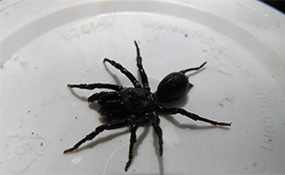
Black purse-web spider (Photo by Rob Craig, Ministry of Natural Resources and Forestry)
Why do some species spook us more than others? Some say it is an evolutionary adaptation, some say it is an irrational fear, while still others say that is because some (like spiders) are always shrouded in myths.
If you’re not a fan of spiders, read on below to learn more about a few common spooky species, and turn your perception of them from awful to awesome.
The case of creepy crawlies
We asked our Facebook followers what species spooked them the most, and spiders came out on top.
Spiders are probably among the most commonly cited groups of species when people speak of things that creep them out. We are sometimes caught by a surprise sighting of one, or literally get caught in their webs.
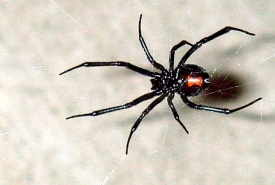
A female black widow spider (Photo from the Wikipedia Commons)
Of the approximately 35,000 species of spiders listed worldwide, only a handful are considered to be dangerous to humans. Spiders are generally shy and non-aggressive, and they are most likely to bite humans when they feel threatened. The infamous but rarely encountered species (in Canada) — the black widows — can deliver more potent venom, but the risk of a bite is extremely rare and bites are not fatal. There are two species of black widow spiders in Canada: the western black widow and the northern black widow.
I can see why spiders hanging out on the ceiling may be scary. Perhaps we’re afraid they’d fall into our mouths while asleep. But the fact that they are able to defy gravity makes them awesome! Thousands of miniscule hairs on their legs create multiple contact points on surfaces (even the smoothest ones), and the force applied by opposing pairs creates the friction it needs to stay put.
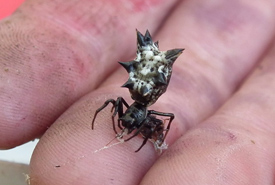
NCC staff holding a fearsome-looking but totally harmless female spined micrathathena (no spiders or humans were harmed in the making of this photograph). (Photo by NCC)
And while unexpectedly walking into a spider’s web may be unpleasant, they’re really meant for a spider’s prey or for themselves as a dwelling. Speaking of webs, not all come in neat, symmetrical construction! The brown recluse spider — native to Canada, the U.S. and Mexico, builds completely irregular webs, often in dry undisturbed places, such as closets, dressers and cardboard in human dwellings. Interestingly, brown recluse spiders do not use their web to hunt; they wander in search of prey instead.
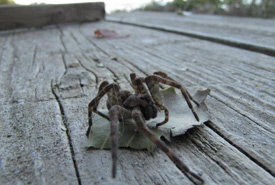
A dock spider (Dolomedes sp.) (Photo by Jill Crosthwaite/ NCC)
The largest spider in Canada is thought to be the species of dock spiders, which is closely related to another large species: the wolf spider. Dock spiders measure up to 10 centimetres, including leg span. Like their name suggests, they are commonly found near ponds or lakes. Despite their menacing size, the spider is harmless and would much rather avoid us.
Some spider species are more elusive, which adds to the challenge of determining whether they are endangered or simply cryptic in nature. For example, the Nature Conservancy of Canada is conducting research to confirm the range and abundance of black purse-web spiders (currently listed as vulnerable).
Show our spiders some TLC
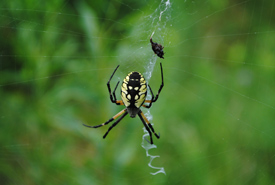
Garden spider at the Rice Lake Plains, ON. (Photo by NCC)
Spiders play an important role in controlling insect populations in the food web. A spider eats about 2,000 insects a year so consider them a friend rather than foe the next time you spot one. Spiders can become collateral damage when pesticides are misused in controlling other insects. Because prey populations usually recover faster than their predators (e.g. spiders) can, it may lead to stronger pesticides being used and turn into a vicious cycle.
For some, arachnophobia is real and research in this topic suggests both genetic and conditioning roots, but research is inconclusive about its origin. If you are among those who shudder at the thought of spiders, you may be interested to know recent research suggests brief exposure to images of spiders may help you become less afraid.
Being the unique, productive members of the food web, spiders really should be tolerated as much as possible. But if you’d rather minimize the encounters, clean your home often, ensure cracks and crevices are covered up and repair tears in screens to limit points of entry to your home.
Perception is hard to change, but knowing more about these species can fill in the voids where some of our fears originate. Have a safe and happy Halloween and be sure to keep an eye out for some of these awesome arachnids!


